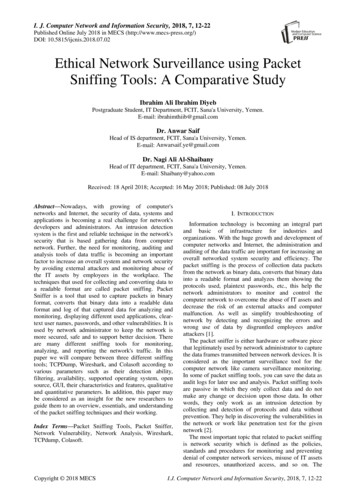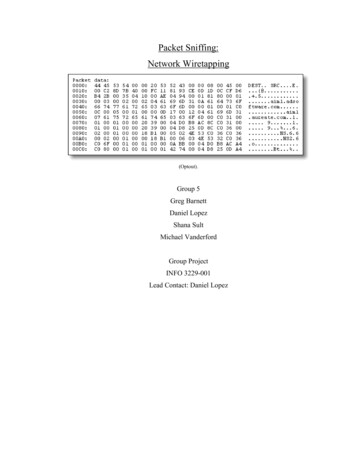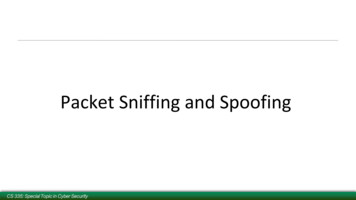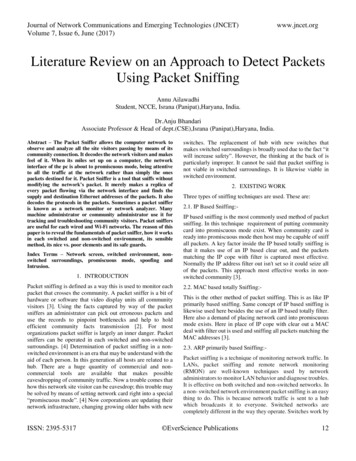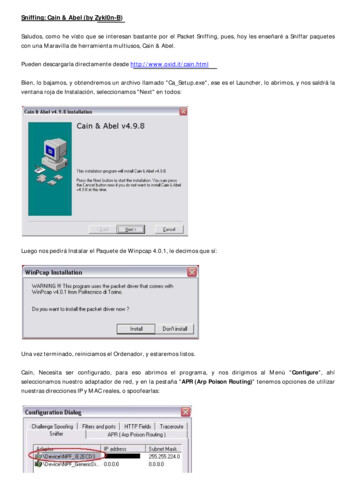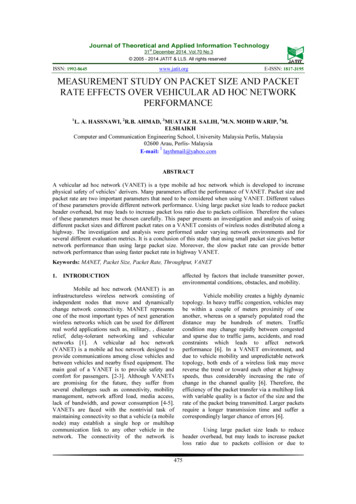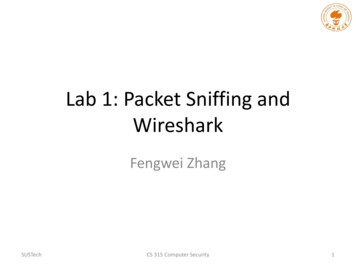
Transcription
Lab 1: Packet Sniffing andWiresharkFengwei ZhangSUSTechCS 315 Computer Security1
Packet Sniffer Packet sniffer is a basic tool for observing networkpacket exchanges in a computer Capturing (“sniffs”) packets being sent/receivedfrom/by your computer A packet sniffer itself is passive Displaying the contents of the various protocol fields inthese captured packets, but never sending packetsitselfSUSTechCS 315 Computer Security2
Packet Sniffer StructureSUSTechCS 315 Computer Security3
Packet Sniffer (cont’d) Applications ( web browsers, FTP clients, email clients ) Network protocols (Internet protocol) Packet capture– The packet capture library receives a copy of every link-layer framethat is sent from or received by your computer Packet Analyzer– Displaying the contents of all fields within a protocol message– Understanding the structure of all messages exchanged by protocols– IP, TCP, HTTP headers Wireshark, TCPDumpSUSTechCS 315 Computer Security4
TCP/IP Network Stack TCP/IP is the most commonly used network model forInternet services. Because its most important protocols, the TransmissionControl Protocol (TCP) and the Internet Protocol (IP) werethe first networking protocols defined in this standard, it isnamed as TCP/IP. It contains multiple layers including:––––SUSTechApplication layerTransport layerNetwork layerData link layerCS 315 Computer Security5
An Example Layered ApproachSUSTechCS 315 Computer Security6
Network LayersSUSTechCS 315 Computer Security7
Application Layer The application layer includes the protocolsused by most applications for providing userservices Examples of application layer protocols areHypertext Transfer Protocol (HTTP), SecureShell (SSH), File Transfer Protocol (FTP), andSimple Mail Transfer Protocol (SMTP)SUSTechCS 315 Computer Security8
Transport Layer The transport layer establishes process-to-processconnectivity, and it provides end-to-end services that areindependent of underlying user data. To implement the process-to-process communication, theprotocol introduces a concept of port. The examples oftransport layer protocols are Transport Control Protocol(TCP) and User Datagram Protocol (UDP). The TCP provides flow control, connection establishment,and reliable transmission of data, while the UDP is aconnectionless transmission model.SUSTechCS 315 Computer Security9
Internet Layer The Internet layer is responsible for sendingpackets to across networks. It has two functions: 1) Host identification byusing IP addressing system (IPv4 and IPv6); and 2)packets routing from source to destination. The examples of Internet layer protocols areInternet Protocol (IP), Internet Control MessageProtocol (ICMP), and Address Resolution Protocol(ARP).SUSTechCS 315 Computer Security10
Link Layer The link layer defines the networking methodswithin the scope of the local network link. It is used to move the packets between twohosts on the same link. An common exampleof link layer protocols is Ethernet.SUSTechCS 315 Computer Security11
Data Encapsulation in Network StackSUSTechCS 315 Computer Security12
Lab 1: Packet Sniffing and Wireshark Fengwei Zhang SUSTech CS 315 Computer Security 1. Packet Sniffer Packet sniffer is a basic tool for observing network . (HTTP), Secure Shell (SSH), File Transfer Protocol (FTP), and Simple Mail Transfer Protocol (SMTP) SUSTech CS 315 Computer Security 8.
